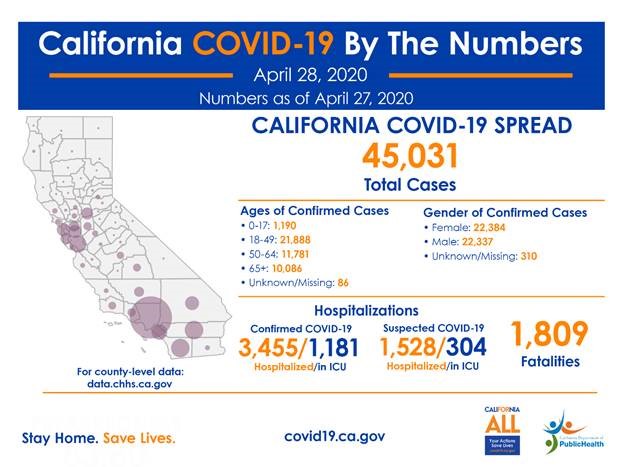SACRAMENTO –The California Department of Public Health today announced the most recent statistics on COVID-19. California now has 45,031 confirmed cases and 1,809 deaths.

New Data Portal
The state has launched a new, user-friendly data portal at update.covid19.ca.gov that tracks COVID-19 cases statewide and by county, gender, age and ethnicity. The portal also outlines statewide hospitalizations and testing efforts. The data presented on the portal will be updated daily and will include additional information as it is available.
Testing in California
As of April 27, more than 577,608 tests have been conducted in California and reported to the California Department of Public Health. These numbers include data from commercial, private and academic labs, including Quest, LabCorp, Kaiser, University of California and Stanford, and the 22 state and county health labs currently testing.
The Department is now reporting all tests reported in California, rather than the total number of individuals tested. As new laboratories begin to test for COVID-19, some have had delays in reporting to the state. To resolve this issue, and to ensure this data is as complete as possible and reflects the state’s entire testing capacity, the Department is contacting laboratories directly to assess the completeness of reporting and to gather additional testing data if needed.
In addition, laboratories have been working through their backlogs of tests awaiting processing, and the backlog has been reduced. This helps ensure we can meet the additional demand expected from broadening testing guidelines and opening 86 additional sample collection sites across California.
Racial Demographics – A More Complete Picture
The California Department of Public Health is committed to health equity and collecting more detailed racial and ethnic data that will provide additional understanding for determining future action. Health outcomes are affected by forces including structural racism, poverty and the disproportionate prevalence of underlying conditions such as asthma and heart disease among Latinos and African American Californians. Only by looking at the full picture can we understand how to ensure the best outcomes for all Californians.
The differences in health outcomes related to COVID-19 are most stark in COVID-19 deaths. We have nearly complete data on race and ethnicity for COVID-19 deaths, and we are seeing the following trends. Overall, for adults 18 and older, Latinos, African Americans and Native Hawaiians and Pacific Islanders are dying at disproportionately higher levels. The proportion of COVID-19 deaths in African Americans is about double their population representation across all adult age categories. For Native Hawaiians and Pacific Islanders, overall numbers are low, but there is a four-fold difference between the proportion of COVID-19 deaths and their population representation. More men are dying from COVID-19 than females, in line with national trends. More information is available at COVID-19 Race and Ethnicity Data.
Health Care Worker Infection Rates
As of April 27, local health departments have reported 4,794 confirmed positive cases in health care workers and 24 deaths statewide.
How People Can Protect Themselves
Every person has a role to play. Protecting yourself and your family comes down to common sense:
- Staying home except for essential needs/activities.
- Practicing social distancing.
- Washing hands with soap and water for a minimum of 20 seconds.
- Avoiding touching eyes, nose or mouth with unwashed hands.
- Covering a cough or sneeze with your sleeve, or disposable tissue. Wash your hands afterward.
- Avoiding close contact with people who are sick.
- Staying away from work, school or other people if you become sick with respiratory symptoms like fever and cough.
- Following guidance from public health officials.
What to Do if You Think You’re Sick
Call ahead: If you are experiencing symptoms of COVID-19 (fever, cough or shortness of breath) and may have had contact with a person with COVID-19, or recently traveled to countries with apparent community spread, call your health care provider before seeking medical care so that appropriate precautions can be taken.
For more information about what Californians can do to prevent the spread of COVID-19, visit covid19.ca.gov.
California continues to issue guidance on preparing and protecting California from COVID-19. Consolidated guidance is available on the California Department of Public Health’s Guidance web page.

